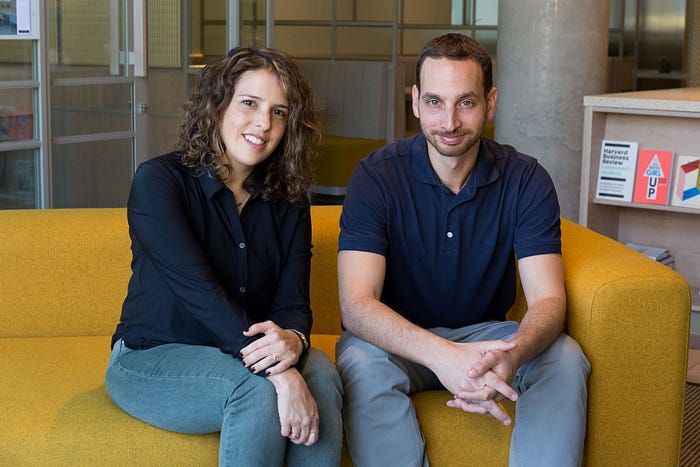
Technology for Trust: Why we invested in Vault Platform
Misconduct Reporting for a Changing Workplace
Late last year, Angular made its fifth investment, and we’re thrilled to be able to announce it publically today. When I first met Neta and Rotem of Vault Platform, in a small café buried deep in Somerset House, their claim was not one I had heard before: “we are going to use cryptographic datastores to solve sexual harassment.”
My initial reaction was basically: “you are going to do what?”
We spent the next two hours going back and forth over what this claim actually meant — and why it might or might not make sense.
Over those hours — and the weeks to follow — Neta and Rotem convinced me that this approach actually did make sense, and — together — we pulled together a small initial round of some like-minded investors alongside Angular to give this pre-revenue, pre-product, pre-code, and pre-team company a shot.
I’m pleased to say now that — several months into this journey — it’s looking increasingly positive. There is a team (including the amazing Freddie Beesley who was head of product at Typeform), there is a working product, there are customers (good ones), and there is even revenue. Josh Bersin, the world’s most respected and quoted HR analyst, endorsed the company by joining the advisory board. So did recently Professor Frances Frei of Harvard Business School (who was hired in the past by Uber to fix their culture issues) (here’s her TED talk on Trust). All of this on a six-figure first-money round and a ton of hard work from some amazing founders.
The idea for Vault was conceived in a conversation between a wife-and-husband team of founders in their kitchen in London. She (Neta) happened to be a governmental policy wonk, and he (Rotem) happened to be an experienced technology leader. Prompted by the #metoo scandals in the US, he asked why women don’t report this sort of misconduct earlier. She answered that women are often afraid of being the only ones to report — navigating a complex process as a lonely, isolated witness. He responded that perhaps technology could provide part of the answer…and the idea of Vault was born. Neta became obsessed with the problem and soon left her job in government to start this important company. Rotem joined her a couple of months later, as the technical co-founder the company needed.
So what exactly is Vault building?

Vault is building a misconduct reporting platform for the next generation of employers and employees. This is about far more than sexual harassment — it works equally well for all manner of misconduct. The idea is to create a secure and immutable logging and reporting system in which witnesses of misconduct (employees, partners, customers) can store their complaints, testimony, and evidence in a way that enables their own ownership of data, inaccessible by their employer or any third parties, and ensures the integrity of the record if and when submitted.. Vault allows the complainants to determine when and under what conditions these reports are released into the hands of the HR department or the compliance department. Vault also is pioneering a novel “go-together” feature that matches reports from different complainants and allows them to condition the release of reports on the existence of multiple related claims — so that employees can feel comfortable that they will not be the only complainant coming forward. Importantly, Vault Platform’s approach is not based on anonymity. On the contrary — Vault is focused on secure, immutable, non-anonymous reporting. Our view is that this is the right way to actually address the problem over the long term: make it possible for witnesses of misconduct to securely and safely report the specifics, attach their name to it, store reports in a vault until they are ready to file them, and ensure that no one — no matter how powerful — can tamper with the data. Accountability rests not just with the perpetrators, but with the complainants and the enterprises as well.
Vault’s philosophy was to reverse-engineer legacy solutions (the misconduct reporting hotlines) and deliver a product that really helps employees. But their technology, which connects the dots on patterns and events that are kept in the dark, is essential for the enterprise. This is a risk mitigation technology for companies in the self-regulation era.
What’s the investment thesis here?
Our investment thesis in Vault has several parts:
- Team. As always, team was a huge part of this investment decision. This team is far from the “traditional” team. They are a married couple and first-time founders. But they are intensely passionate about this problem, deeply thoughtful about how to solve it, and relentless in seeking out the right advice, partners, and team members to make the vision a reality.
- Technology. Vault has built a technologically superior solution to this problem, powered by a technologically sound application of novel cryptographic datastores. Extensive validation of the both the teams’ technical capabilities and architectural choices convinced me that their approach was not only technically sound — but was the only approach that could meet the design criteria of the integrity layer their product has. As Rotem, the CTO, put it: “if blockchain didn’t exist, I’d have to invent it, or something like it.”
- A legitimate use case for immutability. The word “immutability” gets thrown around a lot, but in most cases, it’s actually a false flag. Most databases benefit from having a delete function. There are very few applications where immutability (“append-only”) is actually a feature and not a bug — but misconduct reporting is one of them. Why? Because what matters is the fact that a report took place at all. People may dispute the content of a report — but they can not dispute the fact that a report was filed — and no one can ever tamper with the integrity of the reports.
- Traditional. Despite resting on a foundation of distributed ledger technology, Vault is a traditional enterprise SaaS business with sales cycles and license revenue and ROI — but no tokens or ICOs or DAOs or other buzzwords.
- An existing market. Vault is reinventing the way misconduct reporting works, but misconduct reporting is already a huge business. Large corporations have been struggling for years to provide third-party whistleblowing/reporting capabilities to their employees. It’s hard to come by market data for this industry, but Navex Global, one of the largest providers, is believed to be generating $200M annually for third-party whistleblowing services. Vault is doing this with a novel and innovative approach to misconduct reporting, in a way that proves far more value for employees and employers.
- Generational shift in compliance reporting. Vault benefits from the confluence of three trends: (1) In 2018, compliance and reporting questions are at the forefront of the public and corporate consciousness. The #metoo movement has captured the attention of the media and the public. Corporates are working overtime to figure out a way to address these issues without impacting their business. (2) The second trend is the emergence of blockchain technology as a key enabler of “trustless” applications — applications designed to be deployed into environments that suffer from low trust. The compliance use case is a clear example of a low trust setting. (3) Finally, there is a broad trend towards “democratization” and self-regulation within the enterprise — granting employees the power to control more and more of their destiny at the employee-level without having to run activities and decisions up the corporate chain of command. Software like Vault represents the democratization of compliance reporting. The combination of the emergence of new technology (distributed ledgers), increasing awareness of the importance of compliance, and the trend towards democratization creates a unique moment in which a company like Vault can establish a leadership position in a new category.
One more note: Vault was perhaps the most non-obvious investment I’ve made in a while. As an investor who seeks to be contrarian, I took some comfort in this: the best seed investments are contrarian at seed and obvious at A. Angular’s seed investment in Vault was in a pre-team, pre-code, pre-product, pre-revenue company with a revolutionary approach to a highly controversial market. But the team’s commitment to getting it right and taking on all of these challenges head-on was inspirational. So far, it looks like things are headed in the right direction — and over the next few weeks, we’ll be able to announce a few exciting developments — so stay tuned. Customers are already voting with their dollars.

